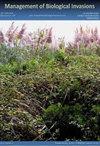三种诱捕器设计对北密歇根湖关键鱼类产卵栖息地锈螯虾(Faxonius rusticus)的抑制效果评价
IF 1.2
4区 环境科学与生态学
Q3 BIODIVERSITY CONSERVATION
引用次数: 2
摘要
在关键的产卵珊瑚礁上,大量入侵的生锈小龙虾对劳伦森五大湖本地鱼类的恢复构成了潜在的障碍。在五大湖,为了保护秋季产卵的本地鱼类,在产卵的珊瑚礁上抑制生锈的小龙虾,但由于定期的风暴事件和周围的天气条件,限制了检查、清理和重新放饵的实际天数。Gee minnow陷阱设计是最常见的小龙虾采样和管理工具,然而标准Gee minnow陷阱的设计限制体现在捕获效率和用户保留之间的权衡。在这项研究中,我们比较了半控制现场试验的捕获率和实验室对照试验的逃逸概率,其中包括一种旨在减少逃逸的改进的Gee minnow陷阱,以及一种在原型阶段发展中显示出潜在前景的实验性平底金字塔设计。应用于捕获数据的广义线性模型的贝叶斯参数估计表明,在捕获率和逃逸概率方面,标准的吉米诺陷阱至少与新设计的陷阱一样好,而且往往更好。在实验室对照试验中,所有陷阱设计的逃逸率都很高,这表明被困个体的滞留是小龙虾监测和管理的一个长期问题。我们从我们的数据中得出结论,标准的吉米诺陷阱是一个明智的装备选择,用于监测和/或潜在的抑制入侵锈小龙虾在五大湖近岸产卵的珊瑚礁。但是,仍应修改其设计以提高留用率。本文章由计算机程序翻译,如有差异,请以英文原文为准。
An evaluation of three trap designs for invasive rusty crayfish (Faxonius rusticus) suppression on critical fish spawning habitat in northern Lake Michigan
High densities of invasive rusty crayfish on critical spawning reefs present a potential impediment to the recovery of native fish in the Laurentian Great Lakes. Suppression of rusty crayfish on spawning reefs to protect fall spawning native fishes in the Great Lakes is hampered by regular storm events and ambient weather conditions, limiting the number of practical days traps can be checked, cleared, and re-baited. The Gee minnow trap design is the most common gear for sampling and managing crayfish, yet design constraints of the standard Gee minnow trap manifest as tradeoffs between capture efficiency and retention for users. In this study, we compared catch rates from a semi-controlled field experiment and escapement probabilities from laboratory controlled trials for a Gee minnow trap, a modified Gee minnow trap with intention to reduce escapement, and an experimental flat-bottomed pyramid design which showed potential promise during prototype-stage development. Bayesian parameter estimation of generalized linear models applied to catch data suggested that standard Gee minnow traps performed at least as well and often better than both novel trap designs in catch rate and escapement probability. Escapement during laboratory controlled trials was high for all trap designs, demonstrating that retention of trapped individuals is a persistent problem for crayfish monitoring and management. We conclude from our data that standard Gee minnow traps are a sensible gear choice for monitoring and/or potential suppression efforts for invasive rusty crayfish on nearshore spawning reefs in the Great Lakes. However, modifications to its design to improve retention should yet be pursued.
求助全文
通过发布文献求助,成功后即可免费获取论文全文。
去求助
来源期刊

Management of Biological Invasions
Agricultural and Biological Sciences-Ecology, Evolution, Behavior and Systematics
CiteScore
3.40
自引率
6.70%
发文量
21
审稿时长
16 weeks
期刊介绍:
Management of Biological Invasions, established in 2010 by Dr. Elias Dana, is an open access, peer-reviewed international journal focusing on applied research in biological invasions in aquatic and terrestrial ecosystems from around the world. This journal is devoted to bridging the gap between scientific research and the use of science in decision-making, regulation and management in the area of invasive species introduction and biodiversity conservation.
Managing biological invasions is a crisis science, with Management of Biological Invasions aiming to provide insights to the issues, to document new forms of detection, measurements and analysis, and to document tangible solutions to this problem.
In addition to original research on applied issues, Management of Biological Invasions publishes technical reports on new management technologies of invasive species and also the proceedings of relevant international meetings. As a platform to encourage informed discussion on matters of national and international importance, we publish viewpoint papers that highlight emerging issues, showcase initiatives, and present opinions of leading researchers.
 求助内容:
求助内容: 应助结果提醒方式:
应助结果提醒方式:


